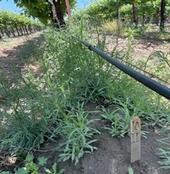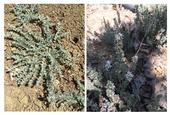- Author: Mick Canevari
- Author: Brent A Holtz
- Posted by: Gale Perez

The 2023 post-harvest season is upon us and it's time to prep for your fall/winter weed control activities. The long-range forecast is calling for another wet winter, and November is the ideal time to plan your early winter weed control program, to check that your spray equipment is functioning properly and calibrated, and to clean your orchard floor of nuts and debris.
There are a variety of herbicides available today for our tree and vine production systems. No one herbicide will control all the weeds present, but choices exist to achieve excellent control for almost every weed combination. However, it takes patience and persistence to win the weed war. Before programs are decided, the following key questions should be...
- Contributor: Marcelo Moretti
- Contributor: Inga Zasada
- Contributor: Jerry Weiland
- Contributor: Tatiana Benedetti
- View More...

I'll share some initial findings from our project, which explores the use of pulse electric fields to eliminate soil pests in hardwood nursery beds, with a particular focus on the impact on weed populations.
Pulse Electric Field as an Alternative to Methyl Bromide
Methyl bromide, a broad-spectrum pesticide for soil disinfection, weed control, and soilborne fungi and nematodes management, is also notorious for its ozone-depleting properties. Consequently, its usage in agriculture has been progressively phased out. Though some essential applications persist, the increasing costs and stringent regulatory standards have made it a less practical choice for pest control.
Pulse Electric Field...
- Author: Trina Kleist
- Posted by: Gale Perez

A contraption with a long, low, green metal arm swept noisily along the edge of a row of almond trees in an experimental orchard just west of UC Davis. Little flashes of light sparked between the bottom of the arm and the green weeds below, and puffs of gray smoke wafted up from the stricken pests.
This tractor equipped with an electrical generator may offer one solution for organic farmers looking for new ways to get rid of weeds. Researchers here and at partner universities have embarked on a three-year project to compare how the machine performs compared to herbicides allowed in organic farming, and to hand-weeding, which has become prohibitively costly.
Electrical energy zooms through the plant down into the...
- Author: Whitney B Brim-Deforest
- Editor: Taiyu Guan
- Editor: Consuelo Baez Vega
- Posted by: Gale Perez

From the UC Rice Blog :: August 23, 2023
* * * * * * * * * *
Pest Control Advisers (PCAs) and growers were very creative and timely in planning and applying products this year, and control was good in many fields. The two most widespread weed control problems that I noticed this year were the watergrass complex and sprangletop. We have widespread resistance, but control issues this year were likely also related to the wet spring, as well as colder temperatures which resulted in different emergence timings and weed growth patterns as compared...
- Author: Phoebe Gordon
- Author: Seth Watkins
- Author: Caleb Crawford
- Author: Elizabeth J Fichtner,
- View More...

Pistachio production has been expanding, particularly into marginal soils with high salts, boron, and even sodic conditions. One plant that is endemic to these conditions, alkaliweed, has been reported in these orchards. While there have been some articles suggesting that it it is a new weed to pistachio production, I am personally a bit skeptical of this, as it is endemic to the American Southwest, found as far south as Baja California, as far east as Texas, and has been reported in Ecuador, Argentina, and Chile. What is more likely is that pistachio production has been expanding into more marginal lands that already contain alkaliweed, and has been noticed more due to its extraordinary and frankly admirable ability to resist control...


